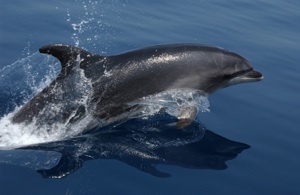Marine Mammal Species Description
Bottlenose Dolphin
Tursiops truncatus
(Montagu, 1821)

Photo credit: Wayne Hoggard NOAA/NMFS/SEFSC
Classification
Order: Cetacea
Family: Delphinidae
Alternate Common Names: Bottlenose dolphin, Gill's bottlenose dolphin. In the southeastern United States, it is sometimes called porpoise.
Status: MMPA Depleted - Western North Atlantic Coastal stock
Description:
Length: 6.6-12.5 ft (2-3.8 m)
Weight: 441-1,102 lbs (200-500 kg); 1,430 lbs (650 kg) maximum
In the northern Atlantic, there are two forms of the common bottlenose dolphin, the coastal and offshore forms. Common bottlenose dolphins in the Gulf of Mexico tend to be smaller than those in the Pacific and offshore in the Atlantic. They have a short beak, a falcate dorsal fin and a fluke with a deep notch. They are dark gray above, fading to lighter grade on the sides and have a white belly. The dark above forms a cape that runs from the melon backward on their body toward their tail.
Habitat:
Common bottlenose dolphins occur in a wide variety of depths and temperatures. They occur in shallow bays, river mouths and other near-shore habitats as well as far off shore. Common bottlenose dolphins occur in schools of a few individuals to less than 20, although schools as large as a thousand individuals have been reported.
Feeding:
Common bottlenose dolphins feed on fish, squid, shrimp and other crustaceans. Common bottlenose dolphins feed independently, as well as cooperatively. They have been recorded using a variety of methods to capture their prey including slapping them out of the water with their tail (fishwhacking), herding fish with other members of their school, and driving their prey close to or onto shore to capture them. In deeper waters, common bottlenose dolphins dive at depths of 1,640 ft (500 m) for up to 5 minutes. Individuals in shallow water dive for shorter periods and not as deep. Common bottlenose dolphins are sometimes seen following fishing vessels to eat discarded fish or shrimp from the boats.
Reproduction:
Females reach sexual maturity around 5-13 years and about 7.5 ft (2.3 m length)). Males reach sexual maturity around 9-14 years. The gestation period lasts about 1 year. Calves are weaned after 1.5-2 years, but remain with their mothers for up to 6 years. Calves may start to feed on their own as early as four months old.
Other:
The maximum life span documented for a common bottlenose dolphin is 57 years for a female and 48 years for a male.
Distribution / Range:
Bottlenose dolphins occur in temperate and tropical waters worldwide. Off the east coast of the United States, the coastal form of bottlenose dolphin occurs along the entire coast during warm months and from the Carolinas south during cooler months. The offshore form of bottlenose dolphin occurs in the Gulf Stream.
Similar species:
Notes:
References:
American Cetacean Society. 2004. American Cetacean Society Fact Sheet. http://www.acsonline.org/factpack/btlnose.htm. Accessed January 2012.
Culik, B. 2010. Odontocetes. The toothed whales: "Tursiops truncates". UNEP/CMS Secretariat, Bonn, Germany. http://www.cms.int/reports/small_cetaceans/index.htm. Accessed January 2012.
Hammond, P.S., Bearzi, G., Bjørge, A., Forney, K., Karczmarski, L., Kasuya, T., Perrin, W.F., Scott, M.D., Wang, J.Y., Wells, R.S. & Wilson, B. 2008. Tursiops truncatus. In: IUCN 2011. IUCN Red List of Threatened Species. Version 2011.2. www.iucnredlist.org. Downloaded on 09 January 2012.
Mead, J.G. 1999. Bottlenose dolphin, Tursiops truncatus. In The Smithsonian Book of North American Mammals. Wilson, D.E. and S. Ruff, eds., 264-265. Smithsonian Institution in association with the American Society of Mammologists, Washington DC.
Wells, R.S. and M.D. Scott. 2009. Common Bottlenose Dolphin - Tursiops truncatus. In: Encyclopedia of Marine Mammals 2nd Ed. Perrin W.F., B. Würsig, and J.G.M. Thewissen, eds. Academic Press, New York, pp. 249-255.

 Marine Mammals of Georgia
Marine Mammals of Georgia